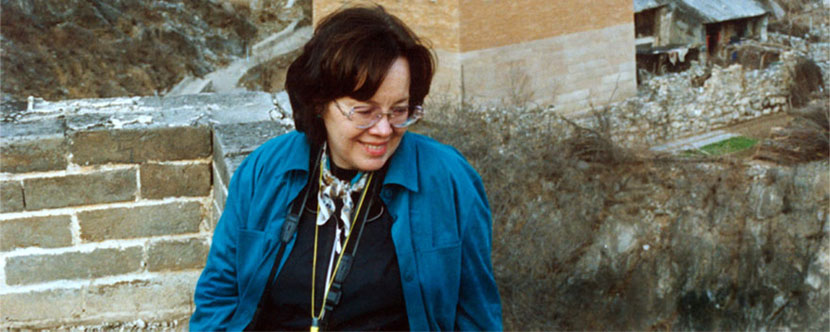VIRGINIA STIBBS ANAMI
Virginia “Ginny” Stibbs Anami (Japanese name: Anami Fumiyo 阿南史代) was orginally an American but after marrying her Japanese diplomat husband Ambassador Koreshige Anami, became a naturalized Japanese citizen in 1970. It was during their three postings to Beijing that Ginny did her field work exploring Buddhist sites both around Beijing and in the countryside. She was particularly interested in the not so well known Liao and Jin Dynasties of northern China: 10th~13th centuries. In the process she found ancient relics and realized that many old sites were marked by magnificent old trees, weathered stones or just a forgotten spring. Ginny then zeroed in on the idea of trees as sentinels of history, an unusual way to study the many layers of Beijing’s past She also collected local lore from unforgettable people and photographed the images of those sites today. Another theme of her research has been the Diary of 9th c. Japanese monk Ennin, photographing what she experienced as she made repeated trips to verify his route of a thousand years ago as a pilgrim to Tang Dynasty China. Ginny writes regularly about her experiences delving into China’s past with these unique angles. She has furthermore helped with several documentaries and held numerous photo exhibitions and lectures in China and Japan.
Background
Ginny Anami was born in the U.S. in 1944 and grew up in New Orleans, LA. where she graduated from Isidore Newman High School. She now lives in Tokyo, Japan, but resided in Pakistan, Australia, China and Atlanta, Georgia when she and her husband and two children were posted around the world. Ginny studied East Asian history and geography at Scripps College in California as well as for her Master’s in Asian Studies while at the East-West Center at the University of Hawaii. She did language studies at the Universite Laval (Quebec), Taiwan Normal University (Taipei), Monterey Institute of Foreign Studies (California), International Christian University (Tokyo) and Australian National University (Canberra). She is currently a lecturer in Chinese history at Temple University, Japan.
It was during their three postings to Beijing in the 1980s, 1990s and 2001~2006 (altogether twelve years) that she was able to do field work originally on Buddhist sites, but which expanded to the study of the Liao (Qidan) and Jin (Jurchen) Dynasties that had made Beijing one of their capitals. The stories of these initial forays into China’s past were written down in Encounters with Ancient Beijing, Its Legacy in Trees, Stone and Water (2004). Using trees as a way to represent the history of important sites, she developed that theme to publish Witnesses to Time: The Magnificent Trees of Beijing (2007) and Walks Among Beijing’s Venerable Trees (2010).(For more, see Publications)
Since 1983 she kept up another line of research making repeated trips to verify Monk Ennin’s route. Following the Tracks of Ennin’s 9th c. Journey, the Diary of a Japanese Monk in Today’s China was published in 2007 and she is continuing her pursuit of the smallest details to make sure that the diary gets the attention it deserves as an important historical document. Since 2001 she and her friends have been planting trees along his route for an “Ennin Green Road” and so far have done so at about twenty places. As an editor of digital mapping of Ennin’s route (a work in progress) collaborating with Harvard University, she hopes that more people around the world will get deeper insight into Ennin’s contributions.
Over the years Ginny has contributed about a hundred magazine and newspaper articles including Asahi Evening News, Jiji Press, People’s China, China National Geography, Women of China and Voice of Dharma.(See Articles) and (See Others). To introduce history through media, Anami has also worked with Japan’s NHK Television on three documentaries and also worked with China’s CCTV and Tianjin TV. Her photo exhibitions and lectures both in China and Japan include pictures of ancient Beijing sites, villages, grand old trees with their stories, and images of the landscape where Japanese monk Ennin walked in 9th c. China. Whenever possible, she visits Sancha Foster Family Village in Shanxi Province that she has assisted over the years. As of 2012, Ginny serves as a trustee of Nishimachi International School (Ginny penned the school’s history: Nishimachi, Crossroads of Culture) and the Kyoto International Convention Center as well as being an adviser to the Beijing Tourism Bureau. In recent years, she was given the “You Bring Charm to China” Award in Beijing (2009) recognizing her work to preserve history and the environment there and was so happy to receive the Distinguished Alumna Award from Scripps College (2011).
Ginny’s family includes her husband Koreshige, daughter Mika (San Francisco and Bogotá), son Yusuke and his wife Miwako (Sendai, Miyagi Pref.) and their daughters Ayaka and Morika. They all enjoy tennis and traveling!

